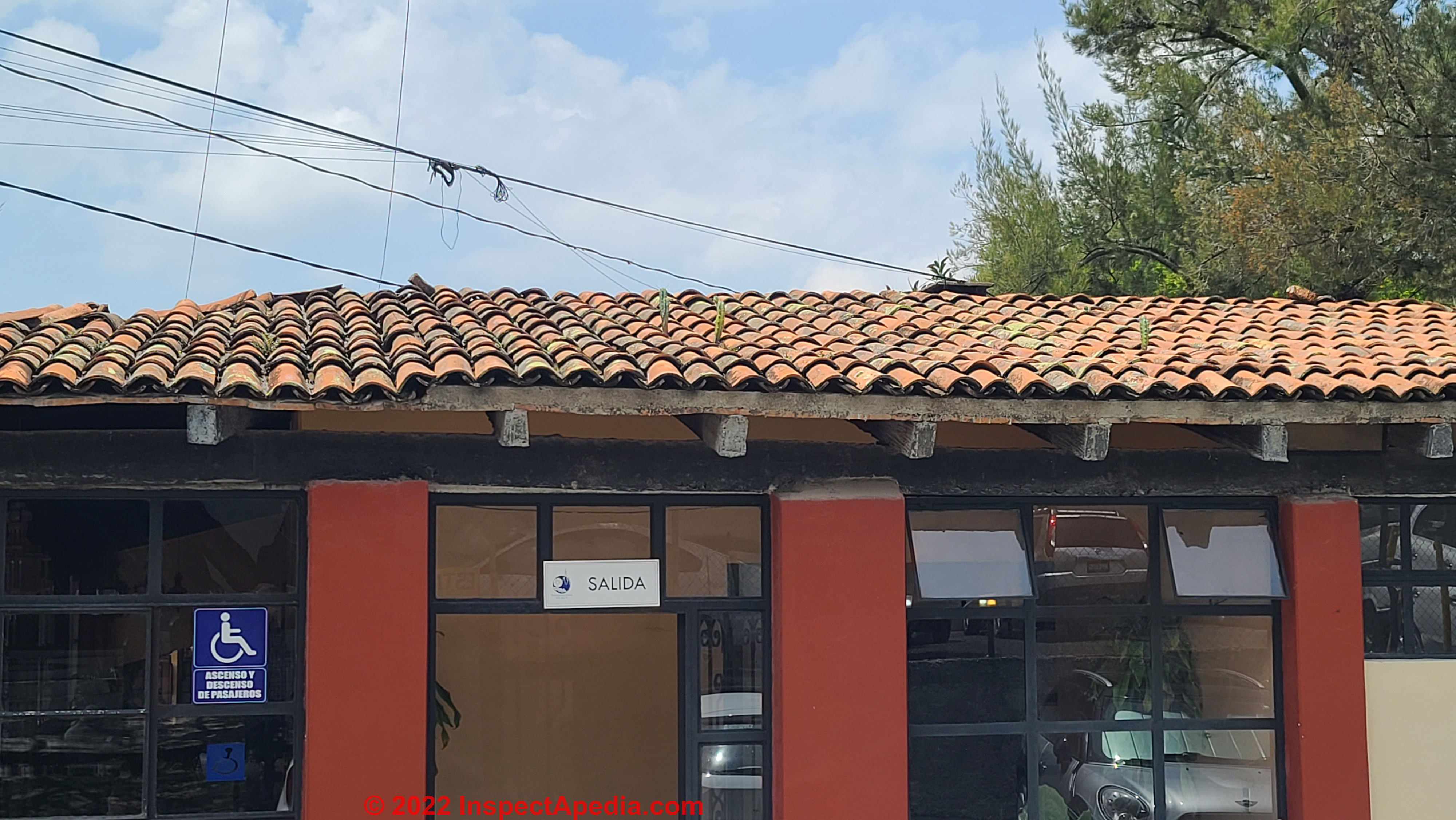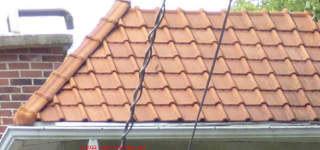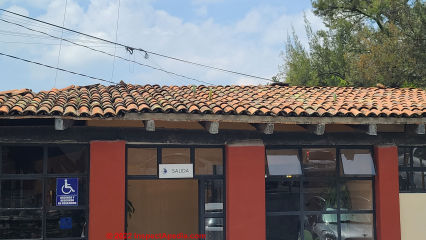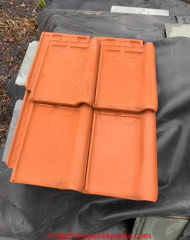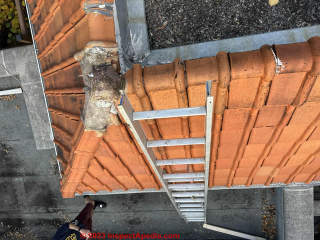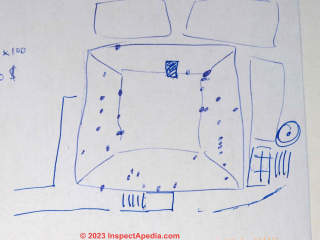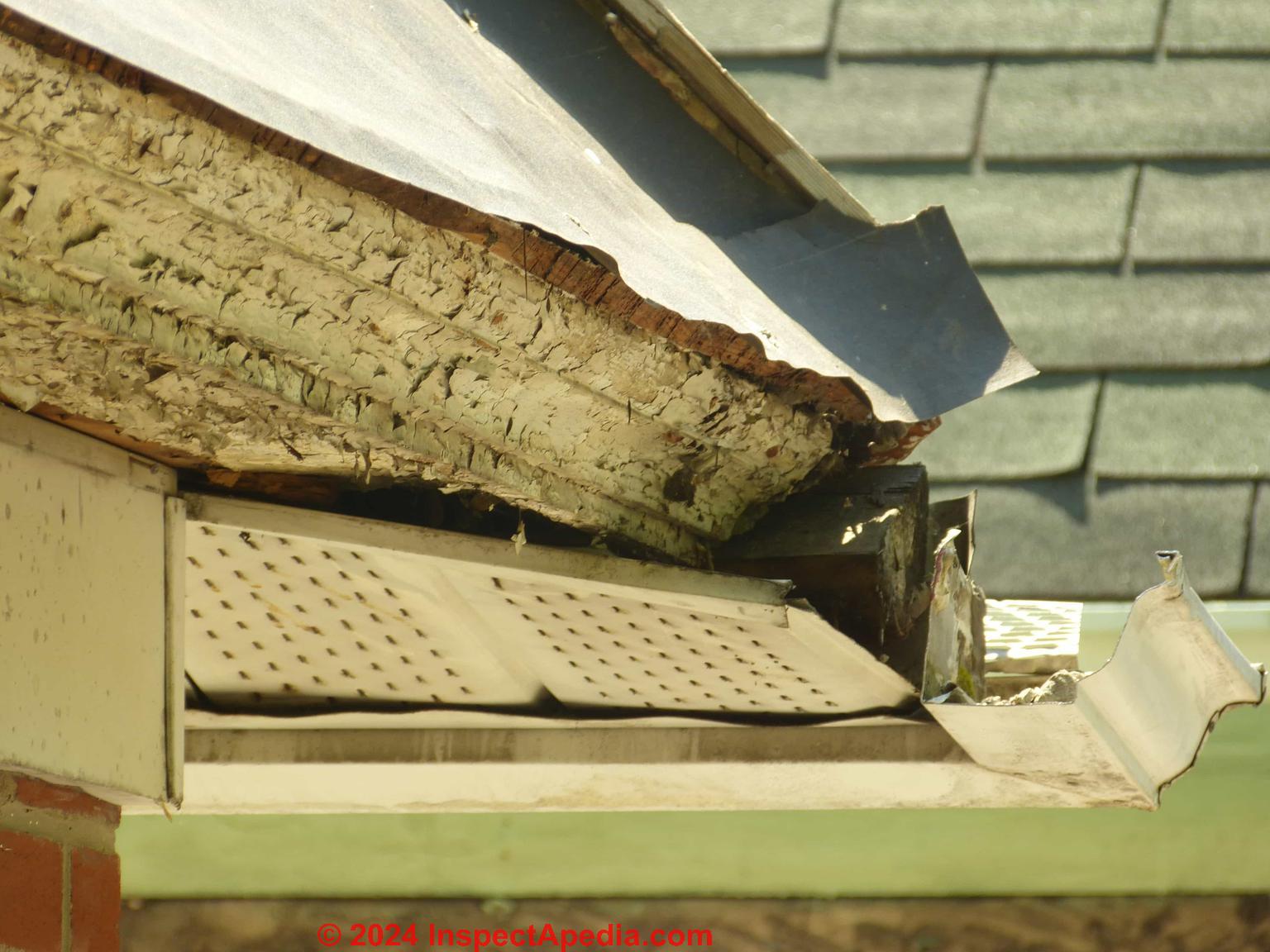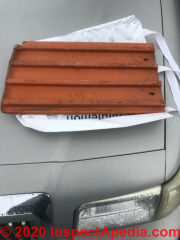 Clay Tile Roof Suppliers
Clay Tile Roof Suppliers
- POST a QUESTION or COMMENT about clay tile roof suppliers
Clay tile roofs: roofing associations and suppliers:
This article provides listings for
- Clay roof tile roofing associations & manufacturers
- Standards history
- Manuals
- Sources & suppliers of clay roofing tiles
- Roof tile fastening systems
- Clay tile roof installation details
Clay tile roofing material is costly to purchase and install, but it can have an indefinite life expectancy.
Our page top photo shows a clay tile roof in Montreal needing specialized replacement clay tiles. Reader Martin shares more in the Reader Q&A section below.
InspectAPedia tolerates no conflicts of interest. We have no relationship with advertisers, products, or services discussed at this website.
- Daniel Friedman, Publisher/Editor/Author - See WHO ARE WE?
Finding suppliers of replacement clay tiles and repair
There can be great variation in clay roof tiles including style, design, size, and other specs. If replacement or repair is needed, finding a supplier or source can be difficult. Below we list some of the available suppliers and clay roof tile associations and manufacturers.
Clay Roof Tile Roofing Associations, Manufacturers, Sources, Standards History, Manuals
- Clay Roof Tile Standards:
European standard PN-EN 538:1999
US ASTM Grade 1 rating for clay roof tiles
Sources of clay roofing tiles, roof tile fastening systems, & Clay Tile Roof Installation Details
- Altusa, Clay Forever LLC, website: www.altusa.com
- Boral Roofing, CONCRETE & CLAY ROOF TILE VALLEY FLASHING INSTALLATION, RIBBED [PDF] (2016) Boral Roofing, Website: www.BoralRoofComponents.com Tel: 1-800-669-TILE, retrieved 2020/02/26, original source: https://www.boralroof.com/wp-content/uploads/boral-resource/Ribbed-Valley-Metal-Installation.pdf
Also see CLAY TILE ROOF FLASHING LEAKS - Crown Building Products, LLC.,
- Dow Building Products, website:
www.dow.com/buildingproducts
Tile Bond polyurethane foam tile adhesive - Duralita: produces cement & cardboard corrugated and clay tile-like roofing products: Duralita is a combination of cement and cardboard - see www.duralita.com/ Si tiene alguna pregunta, por favor escribanos a: sales@duralita.com - El Salvador: +503 22.25.57.44 ext.31 USA +1 305.677.3597 Web: http://www.duralita.com/
- Eagle Roofing Products,
- Fabryka Ceramiki Budowlanej Sp. z o.o. ul. Powstańców Wlkp. 13 63-500 Ostrzeszów NIP: 514-02-13-069 Regon: 251470205 KRS: 0000080021 Sąd Rejonowy Poznań Nowe Miasto i Wilda w Poznaniu IX Wydz. Gospodarczy KRS Kapitał: 2.640.000,00 Export Manager Klaudyna Falkowska tel. +48 665 555 434 tel. +48 62 732 34 44 klaudyna.falkowska@fcbceramika.pl [Poland, ships across Europe & North America]
- Fomo Products, website:
www.fomo.com
Handi-Stick polyurethane foam tile adhesive - FRSA, CONCRETE & CLAY
ROOF TILE INSTALLATION MANUAL [PDF] (2001) Florida Roofing, Sheet Metal and Air Conditioning Contractors Association, Inc., retrieved 2020/02/26 original source: https://www.eagleroofing.com/installation_guides/FRSAInstallationManual.pdf
Excerpt:
These guidelines were developed to summarize for the designer, applicator or developer good roofing practice and industry guidelines for the installation of the mechanically-set and mortar/ adhesive-set tiles, which have been developed over a period of time from actual trade practice and the requirements of various building code agencies.
These guidelines may not be applicable in all geographical areas.
It is the responsibility of those individuals who are referring to these guidelines to independently research and determine which is best for their particular project.
Accordingly, the Florida Roofing, Sheet Metal and Air Conditioning Contractors Association and the Tile Roofing Institute and their members expressly disclaim any express or implied warranties or any liability for any damages or loss that might be incurred as a result of the use of these guidelines. - FRSA/TRI FLORIDA HIGH WIND CONCRETE & CLAY TILE INSTALLATION MANUAL [PDF] (partnership with TRI cited below), 5th Ed. (2014) retrieved 2020/02/26 original source: https://tileroofing.org/wp-content/uploads/TRI-Florida-HW-Tile-Installation-Manual-Revised-5th-Ed-9-24-14.pdf
- Grimmer, Anne E. & Paul K. Williams, The PRESERVATION & REPAIR of HISTORIC CLAY TILE ROOFS [PDF] (1992), U.S. National Park Service, Preservation Brief No. 29, retrieved 2022/10/08, original source: https://www.nps.gov/tps/how-to-preserve/briefs/30-clay-tile-roofs.htm
Excerpt:
Clay tile has one of the longest life expectancies among historic roofing materials—generally about 100 years, and often several hundred. Yet, a regularly scheduled maintenance program is necessary to prolong the life of any roofing system.
A complete internal and external inspection of the roof structure and the roof covering is recommended to determine condition, potential causes of failure, or source of leaks, and will help in developing a program for the preservation and repair of the tile roof.
Before initiating any repair work on historic clay tile roofs, it is important to identify those qualities important in contributing to the historic significance and character of the building.
This Brief will review the history of clay roofing tiles and will include a description of the many types and shapes of historic tiles, as well as their different methods of attachment.
It will conclude with general guidance for the historic property owner or building manager on how to plan and carry out a project involving the repair and selected replacement of historic clay roofing tiles.
Repair of historic clay tile roofs is not a job for amateurs; it should be undertaken only by professional roofers experienced in working with clay tile roofs. - Ludowici Roof Tile, Inc. 4757 Tile Plant Rd. P.O. Box 69 New Lexington, OH 43764 USA, Tel: 1-800-945-8453 4757 Tel: 1-800-945-8453 Website: www.Ludowici.com
Ludowici's BARRELL TILE INSTALLATION MANUAL [PDF] - retrieved 2018/05/21, original source: www.ludowici.com/products/barrel-tile/mission-tile/greek/
- MCA Superior Clay Tile, website:
www.mca-tile.com
CONCRETE & CLAY ROOF TILE INSTALLATION MANUAL [PDF] (2015) Tile Roofing Institute & Western States Roofing Contractors Association, TRI/WSRCA, MCA-Tile, retrieved 2020/02/26 original source: https://www.mca-tile.com/wp-content/uploads/2016/10/TRIDesignManual2015.pdf - Newport Fastener, website: www.newportfastener.com - Twisted wire systems, hurricane clips, nose clips, and the Tyle-Tye TileNail
- OSI Sealants, website: www.osisealants.com RT 600 synthetic rubber tile adhesive
- Polyfoam Products, website: www.polyfoam.cc Polyset and Polyset One polyurethane foam tile adhesives
- Redland Clay Tile,
- Santafe Tile has been a manufacturer of clay roof tiles for over 18 years, supplying Florida, Texas, North and South Carolina, Georgia, Mississippi, Tennessee and Hawaii. Website: www.santafetile.com, Contact: Andrea Pascual, Sales & Marketing Manager, 1-888-305-TILE (8453), Email: arodriguez@santafetile.com
- Roebuck, Mary C. "Archaic architectural terracottas from Corinth." Hesperia: The Journal of the American School of Classical Studies at Athens 59, no. 1 (1990): 47-63.
- Sapirstein, Philip, HOW THE CORINTHIANS MANUFACTURED THEIR FIRST ROOF TILES [PDF] Hesperia (2009): 195-229. retrieved 2018/05/21, original source: http://www.ascsa.edu.gr/pdf/uploads/hesperia/25622692.pdf
Abstract excerpts:
The earliest known terracotta roof postdating the Bronze Age belongs to the 7th century B.C. Old Temple at Corinth.
Analysis of the surface markings preserved on its tiles suggests a hypothesis for the forming and finishing stages of tile manufacture. Individual tiles were built right side up on a mold, with a pair of profiled templates guiding the shape of the top.
Replication experiments reveal that the template design for these tiles is much simpler than formerly believed. Nonetheless, it is likely that the Corinthians created their first tiles in imitation of an earlier terracotta roofing system with separate cover and pan tiles, perhaps developed outside the Corinthia. - Stevens, Gorham Phillips. A TILE STANDARD in the AGORA of ANCIENT ATHENS [PDF], Hesperia: The Journal of the American School of Classical Studies at Athens 19, no. 3 (1950): 174-188. retrieved 2018/05/21, original source: http://www.ascsa.edu.gr/pdf/uploads/hesperia/146775.pdf
Excerpts: Representations of curved roof tiles are carved in full size on the two marble fragments. From the above observations we may conclude that the monument was a standard for roof tiles, and, further, that it was a municipal standard, as it was located in front of the Civic Offices.
The tiles carved on the standard are curved and thin (Fig. 2, plan E-F)-they are representations of Laconian tiles. All Laconian titles, so far as the writer is aware, are made of terracotta and are thin (sometimes as thin as 0.012 m.). Curved tiles, especially if thin, could not easily be cut in marble, and they would, moreover, be liable to break in transporting and setting.
A highly paid stonecutter would have to be employed to produce such marble tiles, and it would take him a long time to make even one tile. All examples of marble tiles known to the writer are of the Corinthian type (flat pan tiles and hipped cover tiles). On account of the expense involved, marble tiles were used only for very important buildings.
The contention that the standard represents terracotta Laconian tiles is supported by the fact that many such tiles have come to light in the excavations of the Athenian Agora, while not one curved marble tile, thick or thin, has thus far been dug up.
The Laconian and Corinthian types of tile are well illustrated by the tile standard at Assos, where curved pan and curved cover tiles as well as flat pan and hipped cover tiles are cut in full size on the same block.5
We may think of the curved tiles of the Assos standard as models for terracotta tiles, and of the flat pan and hipped cover tiles as models not only for marble tiles but also for terracotta tiles, for there are many examples of terracotta flat pan and terracotta hipped cover tiles in Greece.6
Our Athenian standard, then, is concerned solely with the control of terracotta tiles. Now, ancient terracotta tiles have certain characteristics all their own-characteristics which it will be profitable to discuss briefly. ...
Felsch, Rainer CS.
FURTHER STAMPED ROOF TILES FROM CENTRAL GREECE, ATTICA, and the PELOPONNESE [PDF] Hesperia (1990): 301-323. op. cit. retrieved 2018/05/21, original source: http://www.ascsa.edu.gr/pdf/uploads/hesperia/148145.pdf
Contact: in Greece:
ASCSA, 54 Souidias Street, GR-106 76, Athens, Greece Telephone: (+30) 213 000 2400 Fax: (+30) 210 725 0584 Contact Via Email
In U.S.: 6-8 Charlton Street, Princeton, NJ 08540-5232, USA Telephone: (+1) 609-683-0800 Fax: (+1) 609-924-0578
Excerpt:
Founded in 1881, The American School of Classical Studies (ASCSA) provides graduate students and scholars from affiliated North American college and universities a base for the advanced study of all aspects of Greek culture, from antiquity to the present day.
It also contributes considerably to the dissemination of information about Greek history and archaeology to the Greek public, as well as to the international and Greek scholarly communities. - Tile Roofing Alliance, TILE ROOF MAINTENANCE GUIDE [PDF] Tile Roofing Alliance, TRI ALLIANCE
2150 N 107th Street, Suite 205, Seattle, WA 98133 USA, Tel: 206-209-5300, Web: tileroofing.org, retrieved 2022/09/21 original source: https://tileroofing.org/wp-content/uploads/TRIAmaintenanceprotocol_final_single.pdf
TRA or TRI or TRIA (below, apparently an alternative name for the same association, also identified as TRIA - Tile Roofing Industry Alliance ) is an industry trade association - website excerpt:
The Tile Roofing Industry (TRI) Alliance is dedicated to building awareness of clay and concrete roof tile benefits, providing technical expertise, training and certification for code-approved tile roof installation. We’re the tile roofing industry’s voice for code development and installation best practices.
CLAY / CONCRETE ROOF TILE HIP & RIDGE MORTAR GENERATED SURFACE EFFLORESCENCE [PDF] (2014) Tile Roofing Industry Alliance TRIA - cited above, retrieved 2022/09/21, original source: https://tileroofing.org/wp-content/uploads/2019-01-hip-ridge-mortar-generated-surface-efflorescence-r1.pdf
Excerpts: The use of mortar for the attachment and weather blocking of hip and ridge tiles is a code approved option for tile installations.
When mortar is used as a component, either for fastening or weather blocking, there is the opportunity for hip and ridge mortar generated efflorescence to occur on the surface of the underlying roof tiles.
Efflorescence is a temporary surface discoloration common to all concrete based building materials including mortar and concrete roof tiles.
It is superficial and in no way detrimental to the overall quality, structural integrity, or functional properties of the tile.
FLORIDA HIGH WIND CONCRETE CONCRETE & CLAY TILE ROOF INSTALLATION GUIDE [PDF] Tile Roofing Industry Alliance TRIA - cited above, retrieved 2022/09/21, original source: https://tileroofing.org/wp-content/uploads/2020-12-01-TRI-Florida-6th-Ed-Manual-Adoption.pdf
Excerpts: The Tile Roofing Industry Alliance (TRIA), formerly the Tile Roofing Institute (TRI) has recently received the formal code approval on our TRI/FRSA 6th edition of the Florida High Wind Concrete And Clay Tile Installation Guide – 6th Edition. It has been reviewed by the Florida Building Code and has been adopted as part of the new building codes that take effect on 12/31/2020.
While this is the industry-based guide that all our members will refer to, it now requires our manufacturing members to declare that this manual will be part of their official written installation guides as required by code.
The following TRIA Producer member companies have agreed to the above transition date:
Eagle Roofing Products Co. Boral Roofing Crown Building Products, LLC Ludowici Roof Tile. MCA Superior Clay Tile Redland Clay Tile Vande Hey Raleigh Roof Tile Manufacturing Inc. The following Foam Adhesive Manufacturers are also included: ICP Adhesives & Sealants.
OBSOLETE CONCRETE ROOF TILES FORMERLY PRODUCED in FLORIDA [PDF] Tile Roofing Industry Alliance TRIA - cited above, retrieved 2022/09/21, original source: https://tileroofing.org/wp-content/uploads/2020-03-TRI-Tech-Brief-Discontinued-Tiles.pdf
Excerpt: The following roof tiles are obsolete and do not interlock with the profiles currently offered by our existing member roof tile manufacturers. Identifying marks on the back of each tile may include Pioneer, Currier, Entegra, Wallin, Pioneer, Bender and/or Hanson.
POST STORM REPAIR of CONCRETE & CLAY ROOFING TILES [PDF] (2022) Tile Roofing Industry Alliance TRIA - cited above, retrieved 2022/09/21, original source: https://tileroofing.org/wp-content/uploads/TRI_2022-02_Harvest-Tile_F.pdf
Excerpts: Roof tile damage is typically visible to the naked eye. Broken roof tiles often result from large hailstones and flying debris such as tree limbs, yard décor, etc. Broken tiles rarely occur as a result of wind exposure. In order to ensure the integrity of your tile roof, broken roof tiles must be properly repaired or replaced.
... When considering replacing roof tiles, the tile manufacturer should be consulted to determine all viable options, if any, for tiles that will properly interlock and seat with the existing tiles.
Failure to properly seat can lead to leaks, breakage, and improper fit of coursing preventing the tiles from properly performing as designed.
If no tiles exist that can sufficiently interlock and seat with the existing tiles, harvesting tiles from another roof plane or a complete roof replacement may be required. Harvesting tiles from another roof plane and replacing those tiles with new tiles may or may not be a viable option ...
TILE REPLACEMENT CONSIDERATIONS for TILE ROOFS [PDF] (2012) after storms, impact damage, etc. Tile Roofing Industry Alliance TRIA - cited above,
Excerpt: Damage from weather related storms, installation or other impact events can potentially break a roofing tile resulting in the need for a tile repair or replacement.
Perform due diligence of the viable options when locating a replacement tile. While most concrete and clay tiles in the market are still in production, some may no longer be manufactured..
TILE ROOF EVALUATION AFTER HIGH WIND EVENT [PDF] (2012) Tile Roofing Industry Alliance TRIA - cited above,
Excerpt: Unfortunately, misinterpretations of codes typically as a result of insufficient information or misunderstanding in some cases, has led to confusion in the marketplace.
One example is a claim that if the nose of the tile is lifted over 2” the entire roof is not code compliant and must be replaced. This is not representative of testing protocols in the code language.
To better understand, a brief history on the code development for fastener uplift resistance is provided. It should be noted that broken tiles on the roof does not necessarily indicate evidence of wind uplift of tiles. Rather, in a high wind event, tiles are typically broken by impact from airborne debris.
WALKABILITY of CONCERETE or CLAY ROOF TILES [PDF] (2014) - how to walk on clay or concrete roof tiles with more safety and without breaking tiles.
Excerpt: To avoid breaking tiles, there are certain methods of traversing that may minimize damage.
Typically, it is recommended to step at the bottom 3" of the installed tile. This is the portion of the tile that is supported by the lapped tile beneath it and the weight is transferred through it to the deck below.
Orient your feet in a direction parallel with the ridge and try to distribute your weight evenly and walk as softly as possible.
On high-profile “S” tiles, it is recommended to distribute your weight with the heel and toe on the high points of adjacent tiles. It is also recommended to stay away from hips or valleys to avoid breaking cut tiles that would be more difficult to replace.
Watch out: this advice may hold for hard-fired North American clay and concrete roof tiles, but in our experience it is virtually impossible to walk on the much softer and more-fragile clay roof tiles used in Mexico and other Latin American countries. - Ed. - Tile Roofing Institute, 2150 N 107th St. Ste 205
Seattle, WA 98133
USA Tel: 206-209-5300
Website: http://tileroofing.org/ Email: info@tileroofing dot org TRI's Tile Roofing Installation Guides [web page]: http://tileroofing.org/resources/installation-guides/
FRSA/TRI Florida High Wind Installation Manual, Rev. 5th Ed. (2014) download PDF also at https://tileroofing.org/wp-content/uploads/TRI-Florida-HW-Tile-Installation-Manual-Revised-5th-Ed-9-24-14.pdf
or high-resolution at https://tileroofing.org/wp-content/florida/TRI-Florida-Revised-5th-Edition-Tile-Manual-HR.pdf
TRI Concrete and Clay Roof Tile Installation Manual (2015) download PDF also at https://tileroofing.org/wp-content/uploads/TRI-Installation-Guide-2015.pdf
The TRI provides contact information for tile roofers who are members of their association.
Website excerpt:
Founded in 1971 (Incorporated in the state of California, non-profit 501C6), TRI – originally named the National Tile Roofing Manufacturers Association (NTRMA) – has produced technical manuals on code language and preferred installation practices within all the major code bodies nationwide.
TRI has played a major role in testing tile under severe weather and seismic conditions, as well as developing legislation of building codes.
- TRI CONCRETE and CLAY ROOF TILE INSTALLATION MANUAL – 2015 [PDF] lossless-compressed file, 8MB for faster loading,retrieved 2017/0-8/07, original source: http://tileroofing.org/wp-content/uploads/TRI-Installation-Guide-2015.pdf op. cit.
- TRI, "Concrete and Clay Roof Tile Installation Manual for Moderate Climate Regions, Design Criteria", The Tile Roofing Institute, 23607 Highway 99, Suite 2C
Edmonds WA 98026
P: 425.778.6162
F: 425.771.9588
Email: info@tileroofing.org, Website: http://tileroofing.org
supported by the Western States Roofing Contractors Association. retrieved 5/2/2014, original source: http://www.tileroofing.org/tri/wp-content/uploads/2014/01/ TRI_Moderate_Guide_HIGH_RES.pdf - TRI, Tile Roofs Inc., 9505 Corsair Road Frankfort, IL 60423 P: (888) 708-TILE F: (708) 479 7865 EMAIL: INFO@TILEROOFS.COM Vintage & New Clay Roof Tiles & Fittings, Web: https://www.tileroofs.com/
- U.S. Tile Co., website: www.ustile.com
- Vande Hey Raleigh Roof Tile Manufacturing Inc.
- Western States Roofing Contractors Association, WSRCA, 275 Tennant Ave., Suite #106, Morgan Hill CA 95037, Website: www.wsrca.com Email: info@wsrca.com
- Wikander, Örjan. "Archaic roof tiles the first generations." Hesperia: The Journal of the American School of Classical Studies at Athens 59, no. 1 (1990): 285-290.
Excerpts:
This paper further discusses: Why did the tiled roof appear at all, why did it spread as fast as it did, and how was this diffusion achieved.
The basis for my argument is a comparison between documented finds of roof tiles from the period 700-650 and those from 650-600 B.C.
- Wire works, Inc., website:
www.wireworks-inc.com
Tile hooks, hook nails, copper and stainless-steel nails - See also the suppliers listed
at CONCRETE ROOFING
- Portions of this page were adapted with permission from Best Practices Guide to Residential Construction (Steve Bliss, J Wiley & Sons) .
...
Reader Comments, Questions & Answers About The Article Above
Below you will find questions and answers previously posted on this page at its page bottom reader comment box.
Reader Q&A - also see RECOMMENDED ARTICLES & FAQs
On 2022-09-18 by John Sam Hotchkiss - can we restore these flat clay roof tiles from 1927?
We’d like to restore this 1927 roof along with the home. These flat clay roof tiles are not easy to find. Any help would be great! They measure 15 1/2” x 7 1/2” (18 x 39 cm). Thanks!
On 2022-09-18 by InspectApedia (mod) - restore 1927 flat clay tile roof
@John Sam Hotchkiss,
Take a look at the section above on this page titled:
Clay Roof Tile Roofing Associations, Manufacturers, Sources, History, Manuals
where we list a number of clay tile sources. They may be a good starting point and/or could direct you to other suppliers.
Let us know what you find.
On 2022-09-15 by Martin - this website is an incredible wealth of information! Need help with replacing/repairing a Montreal clay tile roof
Hi, this is an incredible wealth of information! I purchased a house in Montreal, built in 1953, with a flat roof and a clay tile "corona" around it. I have a very hard time finding any contractor at all that is able to repair and/or renew that roof.
Here is a pic of my tiles, taken from the flat top. The corner pieces seem a bit special.
best regards - Martin

Practically all buildings in the neighborhood have asphalt shingles at that place.
Do you know of any information source in Canada / Quebec / Montreal that could help me with my search? Until now all I got is a quote for the metal type of tiles, for about 30$ CAD per square feet. But I would very much prefer the original tiling!
Best regards, Martin
On 2022-09-21 by InspectApedia (Editor) - European clay tile sources
@Martin,
Those are very nice tiles and a very steep slope roof - so a bit more trouble (scaffolding & ladders) to work on.
Apparently the roofer knows where to find an exact match. Indeed some North American tile roofers make a point of offering clay roof tiles made in Europe indicating that it's European clay tile sources who continue to produce exact matches for older clay roof tiles no longer made in the U.S. or Canada.
For example this US Supplier tileroofs dot com says
Current production FCB products are manufactured to custom match old Mound City, Heinz, Ludowici-Celadon, B. Mifflin Hood, Mineral Wells, Cincinnati Terra Cotta, Detroit, National (Lima) and many other obsolete and discontinued clay roof tile product lines.
Furthermore, current production FCB colors will match the colors and surface textures of these old clay tile roofs.
With these FCB custom products, you will incur no limitations, restrictions, and/or outright refusal of service such as you may incur from other tile manufacturers in the United States.
Specs concerning FCB:
European standard PN-EN 538:1999 (*Comparable to US ASTM Grade 1 rating for clay roof tiles)
5.6% Water Absorption rating
Suitable for ANY climate
75 year manufacturer warranty
Custom matching for current and/or obsolete clay tile and trim accessories
I'm guessing that their "FCB" refers to Fabryka Ceramiki Budowlanej, a tile manufacturer in Poland
Fabryka Ceramiki Budowlanej Sp. z o.o.
ul. Powstańców Wlkp. 13
63-500 Ostrzeszów
NIP: 514-02-13-069
Regon: 251470205
KRS: 0000080021
Sąd Rejonowy Poznań Nowe Miasto i Wilda w Poznaniu
IX Wydz. Gospodarczy KRS
Kapitał: 2.640.000,00
Export Manager
Klaudyna Falkowska
tel. +48 665 555 434
tel. +48 62 732 34 44
klaudyna.falkowska@fcbceramika.pl
So do let us know the source of your roof tiles as that will be helpful to other readers.On 2022-09-21 by Martin
@InspectApedia (Editor), thanks for all the info... here is a pic of the same spot of our roof from below. I can hardly believe a polish company would produce exactly that... Martin
On 2022-09-21 by InspectApedia (Editor)
@Martin,
I hardly believe it either- sorry if I confused you.
My point was simply to give an example of a U.S. company who imports clay roof tiles from European sources because those tiles are no longer available in the U.S.On 2022-09-21 by Martin
@InspectApedia-911, Hi, my building is located in Cotes-des-Neiges, Montreal. I got a reply from tileroofscanada, saying the tiles will be shipped from Europe... thats what made me wonder. They did not say from where in Europe, though.
On 2022-09-20 by InspectApedia-911 (mod)
@Martin,
Sorry if our article confused you but we certainly do not restrict our roof tile source or product discussions to Europe.
We show roof tiles on the page above from Latin America, Canada, the U.S., Scandinavia, Germany, and other locations around the world, and give and are happy to add to roof tile sources.Not sure where your building is located but we had no trouble finding Flammand roof tiles in Belgium.
Take care when looking at quotes for roofing tiles. The costs of the roof are the labor, including difficulty of access and fragility of the current roof, as well as the particular roof tile selected.
Last month I replace several broken clay tiles on a small roof in Mexico where the individual clay tiles cost less than $1. USD. each. It was the labor, as well as the discovery of need to repair the supporting roof that added to the cost of the job.
An example of one of these inexpensive roofs is shown below.On 2022-09-20 by Martin
@InspectApedia-911,
thanks a lot for the additional links. Meanwhile I got 1 (one!) offer for around 100§ per square feet... (40.000$ for 40 square metres which is 400 square feet). Repair is around 100$ per tile, an individual tile 60$... prices for one tile here in Europe are around 1/10th of that!
When looking at your links it seems all these tiles are imported from... Europe! Why is that so? Don't you have any clay in North America? Our tiles are close to the "44" or "Flamand" type, except the special corner and top tiles seem to be more elaborate. Best regards, Martin
On 2022-09-16 by InspectApedia-911 (mod) - 1953 Montreal home needs special clay tile to renew roof
@Martin,
I agree that you want a roofer who has experience with clay tile roofs - lest the contractor cause more harm than good.
Consider that at least in the 1950s, there were clay tile roofers in Montreal. I'd simply search for the same, perhaps within the whole province.
A quick search for "Clay tile roofer - Quebec" finds
https://www.northernrooftiles.com/aboutus
https://www.cverdun.com/en/tile-roof-in-montreal/
Also some slate roofers can probably handle tile
https://tileroofscanada.com/On 2022-11-16 by Martin - Pottelberg Roof Tiles as Replacement for My Roof: made in Belgium imported clay roof tiles
Hi, here is an update of what we found out so far.
On the back of the tiles on our house in Montreals it reads "Pottelberg - made in Belgium". So even back in the 50ies they used imported tiles! Pottelberg still exists in Belgium (now Niederberger), the tile is still produced and is called "Tempete 44".
Our roofer offers a different tile that looks very much the same, its the "Monopole N1" from Imerys, manufactured in the north of France... Europe again!
One thing I'd like to know is if the tiles the roofer installs are really new. There is a code on the tiles, could that be a production date? Something like week number and two-digit-year? I'm unable to get that confirmed.
What puzzles me is the mention of a plywood replacement in the offer. In Europe you have the large vertical beams with the vertical and horizontal battens that hold the tiles. There is no plywood anywhere. Is there a fundamental difference in European tile roofing standards compared to North-America, or just in Canada?
cheers - MartinHere is the image of the replacement tiles I got from the roofer. It has a code "0221" on it, could it be February 2021? It doesn't look new to me, though.
Another image, same corner, from below
Here is an image of the roof, northwestern corner.
Here are some more photos of the roof. I'm getting a bit uncertain whether its better to repair or to replace the roof. The roofer says its getting fragile. It has endured 70 years of Montreal climate, I for myself cannot really judge, but I remember bits and pieces of tiles coming down when I placed a ladder against the roof.
The first pic shows where I found defective tiles. South is to the left, West to the top. Western and Northwestern part have less damage, maybe due to better accessibility from the surrounding balconies.On 2022-11-16 by InspectApedia (Editor) - ceramic / clay roof tiles are very long lived
@Martin,
Thank you that's an interesting question. Roofing tiles are very durable material and indeed sometimes people salvage them for reuse, particularly if it's a style that's hard to find.
However it should be easy to look at the tile and tell if it's new or used. A new tile will be uniform in color and clean and its color and appearance in the same on both sides as it has not been exposed to weather or allergy or the normal dirt that collects on roofs over time.
In my opinion even a used tile would be perfectly acceptable if it's not cracked or damaged. The material itself has a very long life. Unlike other roofing materials such as asphalt, ceramic / clay roof tiles are very long lived.
What limits their life is usually mechanical damage such as being broken by a storm or by branch falling on the roof or by a walker.Percentage of the roof that's damaged partly dictates repair or replace
Keep in mind that the roofing may have been stored outside or exposed to dirt and debris.
But it looks new to me.
Look closely at the nail holes.
If it was previously nailed to a roof and then removed you would probably see some shipping around the nail holes and even around the edges of the tile. In any case, if the tile's in new condition, I think we're worrying about something that isn't a concern.
About deciding whether to repair or replace a tile roof, usually the roofer will make a statement about the percentage of the roof that's damaged.
If that's a sufficiently high number that the cost of repair approaches the cost of new roof then you would, of course, consider it.
For the information shown by just your photos, it appears to me that you have small areas of damage.
Those are certainly worth fixing.
Keep in mind that you're having to hire someone who has expertise in that particular kind of roofing and that they're working on a high steep slope roof which is more difficult and more dangerous, and therefore more time consuming and more expensive to perform.On 2023-05-21 by Martin - replacement clay tiles found in Belgium and shipped to Canada
Hi,
we made progress for our roof in Montreal. We bought a set of new tiles directly in Belgium and managed to ship them to Canada. Now the roofer is active...
Of course we could have repaired the roof. The problem was that we couldn't find identical tiles, especially for those on the corner. The manufacturer of these tiles, still producing the same ones, made us a quote that wasn't higher than what we would have payed for replacing 30 tiles with whatever was available in Montreal.
Taking down the old roof, the majority of tiles on the northern side are OK. We will keep them, weathered as they are. Could be interesting for other buildings with identical (weathered) in need of repairs. So far we spotted a dozen of buildings in our area of Montreal with exactly the same tiles, most of them with broken ones here and there.
So if there is interest in some genuine 1952 Stormpan 44 "Pottelberg made in Belgium", let me know ;-)
cheers
Martin
On 2023-05-21 by InspectApedia Publisher
@Martin,
Thank you for the follow-up. That information will certainly be helpful to other readers with tile roofs in need of repair and who are looking for matching roof tiles for roofs installed in the 1950s.
We'll be sure to keep the information here for others to find.On 2023-05-21 by Martin
when we took down the roof, we also took down the aluminium gutters and "soffite". The unveiled the original woodwork that was underneath the roof. Although the paint is poor, the wood itself is in excellent shape and I would like to keep it exposed.
The contractor has some reserves as to venting the space behind the wood without the aluminum cover. I do not understand why - venting shouldn't be worse without the aluminium cover.
Also, we're looking for a way to reconnect a gutter to the roof that does not require a vertical base to be mounted to. The original roof did not have gutters at all - why did they fit these ugly gutters for such a relatively small roof?
cheers
Martin
attached pics of gutters and what is underneathOn 2023-05-21 by InspectApedia Publisher
@Martin,
There are gutter hanger brackets that can accommodate and in sloped fascia like the one in your photo.
Be sure to include a good drip edge so that water spills only into the gutter and doesn't run down the surface of the wood where it over time can lead to rot or invite insect damage.
About why people would put gutters on a small roof, I would need to see more of the whole building to be sure, but very often a small roof also receives water from an upper roof so it has more water to dispose of than you might have thought.
Also depending on the buildings footprint run off from a small roof might happen to fall into an area that particularly sends water into the buildings crawl space or basement.
You definitely want to control roof run off, and to get it away from the building.On 2023-05-21 by Martin
@InspectApedia Publisher,
thanks for the helpful comment, in particular the dripping edge. I'll check that with the roofer.
Our roof has a 45° incline, and about 3ft of footprint in depth. Thats not much. Many houses in the area have that kind of "corona" around a flat roof on top, sometime much steeper. So they do not collect much rain, they did not have gutters when they were built, and many still do not have.
This can be easily spotted on satellite and street images in "cotes de neiges" (and many other parts) in Montreal.
cheers
Martin
On 2020-03-16 by yessica henriquez - what's the name of this roof tile and where can I find more?
Can someone please tell what is the name of this clay tile and where I can buy it.
On 2020-03-17 - by (mod) -
Yessica
That's a flat clay roofing tile.
Above in this article, see the list of clay roofing tile manufacturers and sources.
...
Continue reading at CLAY TILE ROOF BATTENS & STACKING or select a topic from the closely-related articles below, or see the complete ARTICLE INDEX.
Or see these
Recommended Articles
- CLAY HOLLOW TILE CONSTRUCTION - Structural clay tile, terra cotta, building tiles
- CLAY TILE / PAVER TILE FLOORING
- CLAY TILE ROOFING - home
- CLAY TILE ROOF BATTENS & STACKING
- CLAY TILE ROOF CONNECTIONS
- CLAY TILE ROOF DAMAGE & WEAR
- CLAY TILE EAVES, HIP & RAKE DETAILS
- CLAY TILE ROOF FLASHING
- CLAY TILE ROOF FLASHING LEAKS
- CLAY TILE ROOF SLOPE, DECK & UNDERLAY
- CLAY TILE ROOF SPECIFICATIONS
- CLAY TILE ROOF SUPPLIERS
- CLAY TILE ROOF STYLES, DESIGNS
- CLAY TILE ROOFING
- CLAY TILE WIND & SEISMIC CONNECTORS
- CLAY, CONCRETE, FIBER CEMENT ROOF TILE CHOICES
- CONCRETE, MASONRY BLOCKS, & BRICKS, WORKING WITH
- CONCRETE ROOFING
- DURALITA & METAL TILE ROOFS
- EFFLORESCENCE: WHITE DEPOSITS on ROOFS
- ROOFING CONTRACTOR, FIND & CHOOSE
- ROOFING TILE SHAPES & PROFILES - for both clay or concrete roof tiles
- SLATE ROOF INSPECTION & REPAIR
Suggested citation for this web page
CLAY TILE ROOF SUPPLIERS at InspectApedia.com - online encyclopedia of building & environmental inspection, testing, diagnosis, repair, & problem prevention advice.
Or see this
INDEX to RELATED ARTICLES: ARTICLE INDEX to BUILDING ROOFING
Or use the SEARCH BOX found below to Ask a Question or Search InspectApedia
Ask a Question or Search InspectApedia
Try the search box just below, or if you prefer, post a question or comment in the Comments box below and we will respond promptly.
Search the InspectApedia website
Note: appearance of your Comment below may be delayed: if your comment contains an image, photograph, web link, or text that looks to the software as if it might be a web link, your posting will appear after it has been approved by a moderator. Apologies for the delay.
Only one image can be added per comment but you can post as many comments, and therefore images, as you like.
You will not receive a notification when a response to your question has been posted.
Please bookmark this page to make it easy for you to check back for our response.
Our Comment Box is provided by Countable Web Productions countable.ca
Citations & References
In addition to any citations in the article above, a full list is available on request.
- Best Practices Guide to Residential Construction, by Steven Bliss. John Wiley & Sons, 2006. ISBN-10: 0471648361, ISBN-13: 978-0471648369, Hardcover: 320 pages, available from Amazon.com and also Wiley.com. See our book review of this publication.
- Mark Cramer Inspection Services Mark Cramer, Tampa Florida, Mr. Cramer is a past president of ASHI, the American Society of Home Inspectors and is a Florida home inspector and home inspection educator. Mr. Cramer serves on the ASHI Home Inspection Standards. Contact Mark Cramer at: 727-595-4211 mark@BestTampaInspector.com
- John Cranor [Website: /www.house-whisperer.com ] is an ASHI member and a home inspector (The House Whisperer) is located in Glen Allen, VA 23060. He is also a contributor to InspectApedia.com in several technical areas such as plumbing and appliances (dryer vents). Contact Mr. Cranor at 804-873-8534 or by Email: johncranor@verizon.net
- Duralita: produces cement & cardboard corrugated and clay tile-like roofing products: Duralita is a combination of cement and cardboard - see www.duralita.com/ Si tiene alguna pregunta, por favor escribanos a: sales@duralita.com - El Salvador: +503 22.25.57.44 ext.31 USA +1 305.677.3597
- Roof Tiling & Slating, a Practical Guide, Kevin Taylor, Crowood Press (2008), ISBN 978-1847970237,
If you have never fixed a roof tile or slate before but have wondered how to go about repairing or replacing them, then this is the book for you. Many of the technical books about roof tiling and slating are rather vague and conveniently ignore some of the trickier problems and how they can be resolved. In Roof Tiling and Slating, the author rejects this cautious approach. Kevin Taylor uses both his extensive knowledge of the trade and his ability to explain the subject in easily understandable terms, to demonstrate how to carry out the work safely to a high standard, using tried and tested methods.
This clay roof tile guide considers the various types of tiles, slates, and roofing materials on the market as well as their uses, how to estimate the required quantities, and where to buy them. It also discusses how to check and assess a roof and how to identify and rectify problems; describes how to efficiently "set out" roofs from small, simple jobs to larger and more complicated projects, thus making the work quicker, simpler, and neater; examines the correct and the incorrect ways of installing background materials such as underlay, battens, and valley liners; explains how to install interlocking tiles, plain tiles, and artificial and natural slates; covers both modern and traditional methods and skills, including cutting materials by hand without the assistance of power tools; and provides invaluable guidance on repairs and maintenance issues, and highlights common mistakes and how they can be avoided. The author, Kevin Taylor, works for the National Federation of Roofing Contractors as a technical manager presenting technical advice and providing education and training for young roofers. - In addition to citations & references found in this article, see the research citations given at the end of the related articles found at our suggested
CONTINUE READING or RECOMMENDED ARTICLES.
- Carson, Dunlop & Associates Ltd., 120 Carlton Street Suite 407, Toronto ON M5A 4K2. Tel: (416) 964-9415 1-800-268-7070 Email: info@carsondunlop.com. Alan Carson is a past president of ASHI, the American Society of Home Inspectors.
Thanks to Alan Carson and Bob Dunlop, for permission for InspectAPedia to use text excerpts from The HOME REFERENCE BOOK - the Encyclopedia of Homes and to use illustrations from The ILLUSTRATED HOME .
Carson Dunlop Associates provides extensive home inspection education and report writing material. In gratitude we provide links to tsome Carson Dunlop Associates products and services.



